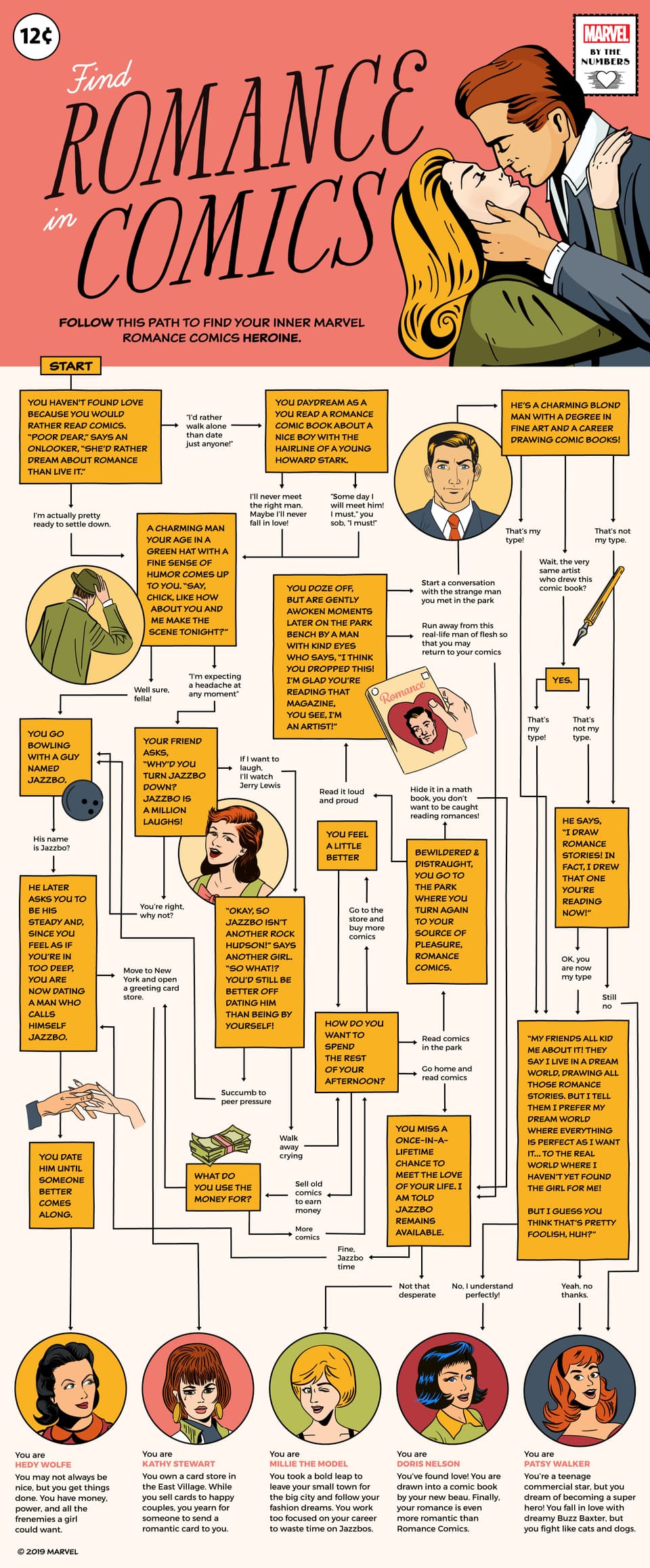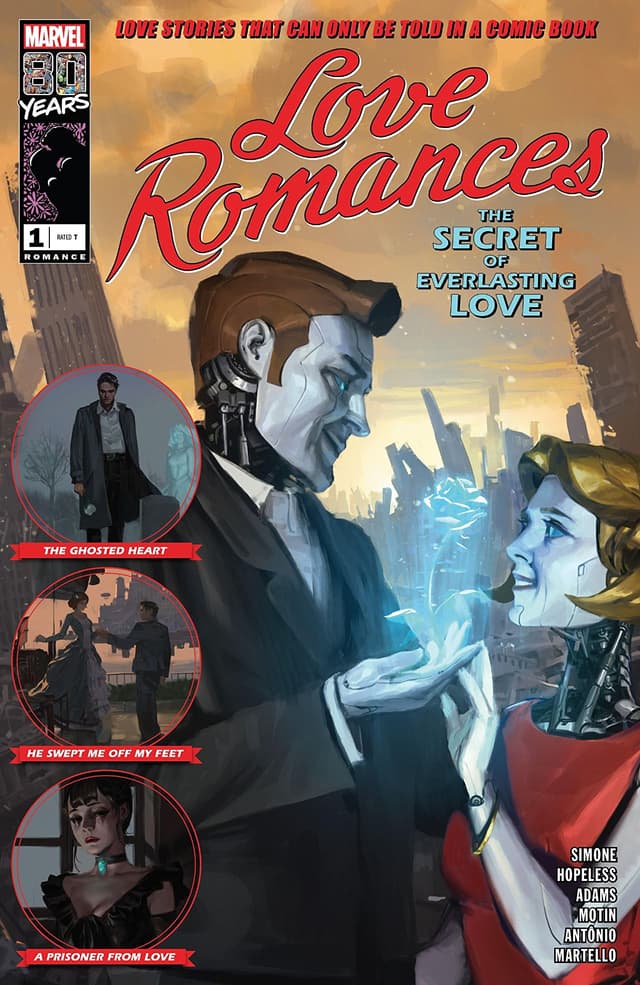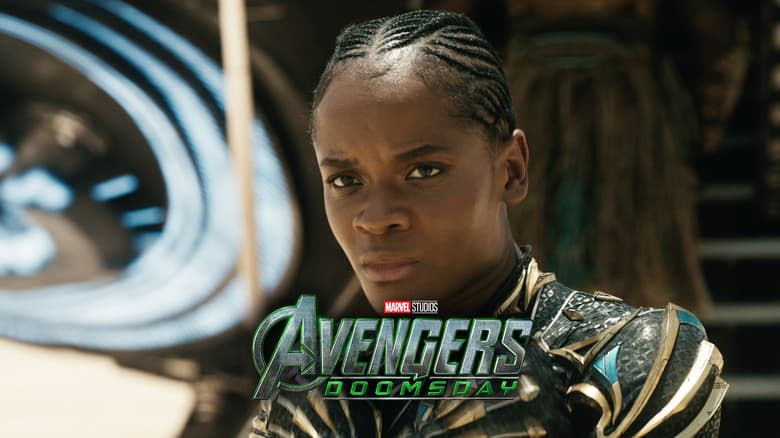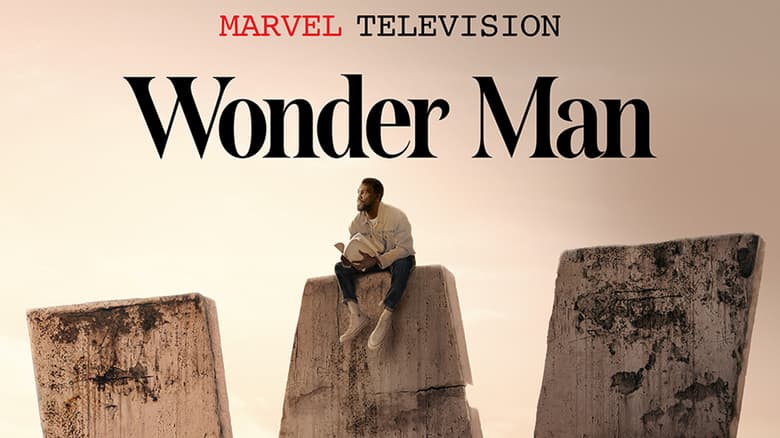Marvel By the Numbers: Romance in Marvel Comics
Find your inner Marvel romance comics heroine as Walt Hickey delivers an infographic breakdown of the classic genre!
Next week, Marvel returns to an iconic genre of comics that once defined the brand with LOVE ROMANCES #1!
It’s a callback to a totally different era of comic books, and is a chance for the creators of today to take a stab at a format that launched so many greats. Marvel produced hundreds of romance comics between the end of the second World War and the late 1970s; they’re products of their era, sure, though the motivation to land a swell relationship with a fella on the up-and-up transcends time!
For decades, these books trained a generation of Marvel greats on storytelling and design. The Marvel universe still feels their resonance—particularly when Patsy Walker AKA Hellcat shreds a baddie...
In anticipation of the new issue, I pulled an anthology of those comics—the MARVEL ROMANCE trade paperback, which holds 24 unique stories from across the decades—to find out just how these stories operate. These aren’t just oldies by a bunch of obscure wordsmiths, either: Stan Lee, Jack Kirby, John Romita, and John Buscema all cut their teeth in the romance section, and their sense of pacing, eye for design, and intuition for storytelling come off regardless of whether or not the protagonist wears a cape.
While many Marvel readers are accustomed to peril of the Super Villain variety, a simple analysis of these comics tells us that the path to romantic success was still pretty fraught! To put you in the shoes of the women of Marvel’s romances, we built this interactive adventure—assembled from a story in LOVE ROMANCES #103 from 1963—to help you get in the mindset of our heroes.
See if you can choose correctly and land the fella you’ve got your eye on!

You went on the date with Jazzbo, didn’t you? They always go on the date with Jazzbo.
From a storytelling prospective, my analysis of the 24 stories collected lay out a pretty simple set of rules in order to keep the readers happy.
The average length of each story runs just over 7 pages, and that includes the cover, so you’ve got to get to work quickly. There’s always got to be a real sense of danger, too—1 of every 6 stories end in heartbreak for our protagonist, so there’s a strong chance that a wrongheaded move can leave you desperate, alone, or in some bowling alley with a guy in a green hat.
Still, there’s a reason the cover of the book says LOVE ROMANCES: give the people what they want! And that translates to a loving embrace every 1.5 pages, on average, and no fewer than 1 kiss every 4 pages.
But the most distinctive part of these stories is that they’re about the nuanced and rich inner life of the woman at the center of the story. Marvel’s always featured strong women, and look no further than the sympathetic and compelling portrayals in these stories to see where that may come from. In every single story, the number of speech and thought bubbles coming from female characters outnumbers the bubbles coming from male characters. Women have about 71% of the dialogue, by my reckoning, which is rare in any medium. In almost 66% of the stories, the women out-talk the men 2-to-1, a ratio rarely seen in any medium.

And there are bigger things at play here—things that would go on to define the company. It’s important to remember that while the Fantastic Four kicked off a heroic age the likes of which comics hadn’t seen before—an interconnected universe of super powered people in interlocking and overlapping stories—Marvel was in the comics business long before the invention of Spandex in ‘59.
Those stories laid the groundwork for the characters and storytelling styles that would define Marvel and comics for years. Without two lines of science fiction anthologies, you don’t get the Hulk, Ant-Man, or Iron Man. Without a line of horror and supernatural comics you don’t get Thor. Without the line of sci-fi and fantasy comics you don’t get Spider-Man!
In much the same way, the thing that made Marvel unique—underneath the costumes, real people having real relationships, arguing, disagreeing, miscommunicating, and then coming together in the end—you can draw a direct line between that in-house sensibility and the romance comics that Marvel rolled out over those formative years. These stories served as an essential connection to an audience predominantly comprised of women, and would serve as an on-ramp for the medium for a generation of fans.
Even more, they also taught creators about what worked on the page when it came to relationships. So many of the classic teams and characters of Marvel are defined by their relationships—Reed and Sue, Peter and Mary Jane, Scott and Jean, Hulk and Smash. Those (at times tumultuous) relationships became the signature appeal of Marvel; these weren’t just characters fighting henchmen, they weren’t boy scouts in capes, and they certainly weren’t perfect. The romance comics that were worked on by the creative founders of Marvel were integral in crafting those iconic characters—just as integral as the science fiction anthologies that led to their backstories. While some are quick to look past it, OUR LOVE STORY, LOVE ROMANCES, MILLIE THE MODEL, and PATSY AND HEDY are rife with the interpersonal drama and nuanced characters and compelling designs that would define Marvel at the time. And beyond that, they were absolutely instrumental in getting Marvel where it needed to be.
That so many luminaries of Marvel’s history all worked on books where relationships are front-and-center shouldn’t come as a shock, as it’s that capacity to tell stories about relationships that brought comics into the modern era to begin with.
That’s why the new issue of LOVE ROMANCE is so exciting... A new generation of creators get to try their hands at one of the oldest stories in the book—about a person that wants to be loved and what that person will do to be loved. Sure, the old stories could get a tad formulaic (and maybe they relied a little much on exclamation points at times!!!), but now we get to see a modern spin on the old heroines, and once again we get to put these icons back in the spotlight.
Well, except Patsy Walker. Patsy’s been doing great these days, ever since dumping her top romance comics beau when he decided to become a Super Villain.

"A.I.M. Intern" Walt Hickey is a data journalist and writes the daily morning newsletter Numlock News. His work has previously appeared on FiveThirtyEight and Business Insider.
The Daily Bugle
Can’t-miss news and updates from across the Marvel Universe!




